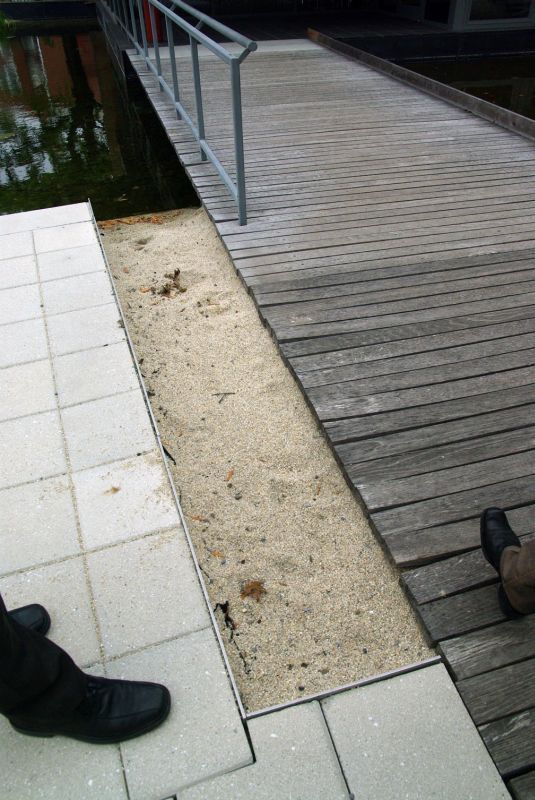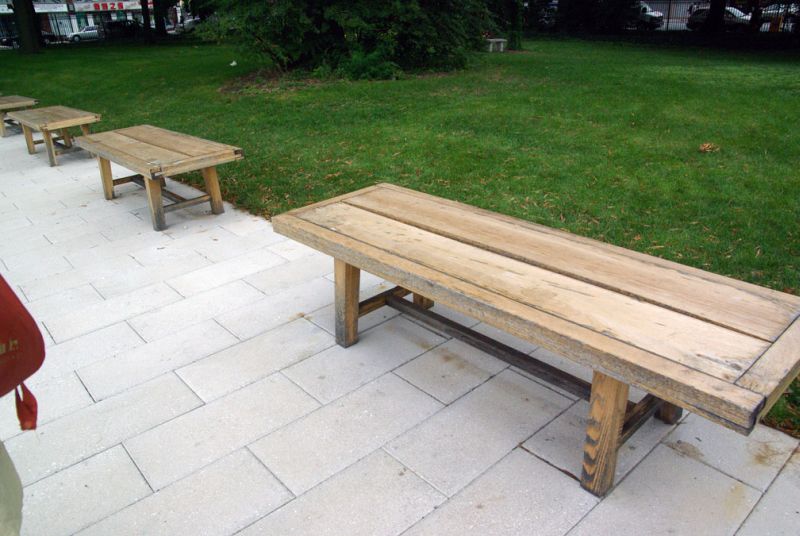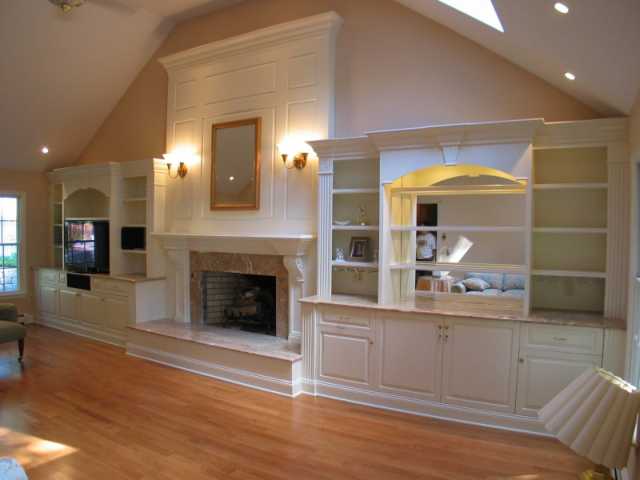Black Locust Durability for Outdoor Decking
A discussion of the suitability of Black Locust wood for outdoor use as decking or for benches. May 6, 2009
Question
From reading other threads at WOODWEB, it would appear that black locust is an incredible wood second only to tropical hardwoods in aesthetics, durability, rot resistance and strength. However, these pictures of the Queen's Botanical Gardens, NYC show that it weathers very badly and warps. We have specified this for a big city project and can't afford for this to happen. Has the wood in these pictures been installed incorrectly or should we spec a different species, and if so, what? Most native woods seem to be too soft for decking in public areas and the city will not allow us to use tropical hardwoods.

Click here for higher quality, full size image
Black Locust Uses
Forum Responses
(Architectural Woodworking Forum)
From contributor P:
I've used locust in the past and never had that problem. The lumber I used was air dried, not kiln dried, and possibly that made the difference.
From the original questioner:
Not only was the black locust used as decking warped, but the black locust used on the benches is split and looks rotten. Black locust is often cited as one of the most rot resistant North American woods. If it was kiln dried rather than air dried, this might explain the warping, but not the rotten areas. Can there be other explanations?

Click here for higher quality, full size image
From contributor A:
I think an issue that needs to be included in any discussion is the grade of the material. Rot resistant qualities aside, a piece of wood is only going to be as good as the quality of the tree it came from, and the portion of the tree the board was cut from. Was the material graded, and if so, what was the grade? In my area (northern PA), it's really tough to find straight, clear black locust trees. Also, there's been no discussion of what finish was applied?
From contributor L:
The warping would be much less if quartered material were specified. The sapwood is not rot resistant, so should not be used. All wood will turn gray upon exposure to the elements; most clear finishes will fail within a few years. Structural design should take into consideration the movement that the wood will go through due to its exposure to hugely variable moisture conditions.
From contributor F:
I used to cut a lot of locust, mostly for firewood, but I remembered that there is black locust and honey locust. Black locust is more decay resistant. Both trees look similar but one has thorns and the other doesn't. The wood looks similar too. I would bet that someone sold honey locust to the botanical gardens and that's why it is in the condition you see in the pictures. My advice: Learn the differences and make sure you get black locust for your project.
From contributor C:
It is important that any joints in outdoor furniture either be well caulked or able to drain. Otherwise water will stand in the joint and lead to rot. I have never found any untreated North American wood that wouldn't rot, eventually. It takes proper material selection, construction and finish to make things last outside. Do things correctly and you will have a good chance that the material will not fail.
From the original questioner:
Have any of you seen black locust used successfully for decking and/or outdoor furniture? My research so far shows that the wood has been barely used in any public projects, at least in New York City, but I may be missing something.
From contributor B:
I agree with previous posters. Grading and sawing are important, as well as all heartwood. Also, if you look closely at the deck, the ends which are not secured but are floating seem to be the source of the twisting. Plan your substructure better to eliminate the loose ends and it will last much longer and stay flatter. I think it is as good as any tropical and I would lean towards air dried as well. I know white oak fares much better used outside when air dried versus kiln dried.
From the original questioner:
Quartersawn is a great idea, but it seems almost impossible to find quartersawn black locust in the larger dimensions (we were trying to source 2x6s). Does anyone know of a supplier who deals with larger lumber sizes for black locust?
From contributor J:
It is not uncommon where I am from to pull of a piece of Southern yellow pine from an 80 year old house and have it be better than new. Quartered SYP is harder than most hardwoods. What about a Trex like product?
From contributor W:
In today's highly competitive air it is so important to specify all these details in products, species, grade, thickness, initial and maintenance finishing. Specify a thicker, better graded, jointed plank. And most definitely specify a good exterior finish and maintenance recoating.
From the original questioner:
Would it be advisable to spec a different wood than black locust for outdoor furniture and decking? I have been looking at white oak, hickory, Douglas fir and Southern pine. Am I missing any? What are the strengths and weaknesses of the above group? It is for a very high traffic area, so it can't be too soft.
From contributor Z:
Doug fir and pine will be too soft and not have the decay resistance you want. Hickory is not known for good decay resistance. If you want a softwood, perhaps consider redwood, if it isn't too soft for your needs. White oak heartwood, Osage orange and black locust are the domestic hardwoods most frequently cited with good decay resistance. I've had trouble finding Osage orange in the sizes you specified, and it is often priced like rare exotics. I also have trouble sourcing long, clear black locust, though pricing is always favorable. White oak heartwood is quite easy to get in the sizes you require.
It is possible that the black locust referred to in the pictures above was not pre-dried well. This seems to me to be a problem with the less permeable, rot resistant hardwoods. It is easy to split and check the wood in the early stages of drying, leaving it more open to the elements later.
From contributor V:
Let's face it, teak and ipe` are two of the best woods in the world for doing what you wish to do. To attempt it with anything less will be a compromise, with lower performance than the woods mentioned. Even with teak, joints have to be of a certain type and sloped to drain water. Finish is not practical for your application. Teak does not require a finish in exterior use - looks far better without it, in fact.
I'm all for domestic lumber use, but your expectations have to be lowered if you use something less than imports for this use. There is no secret answer to your query. Some things will get close, but will not perform like a few of the imports.
Don't you agree that if there was a domestic wood that performed as well as teak, we would all know about it, and this post would never have been written? No free lunch on this one, I'm afraid.
From Professor Gene Wengert, forum technical advisor:
I suggest that you might consider "plastic lumber" that is made of polyethylene and mixed with some wood fiber. It is sometimes called WPC lumber (wood-plastic composite). (There are over 50 different types of plastic lumber and some are not as good as others.) For a decking material, you also probably want a bit higher density material to achieve good strength and hardness. As one good example, consider maclumber.com.
From contributor O:
We have worked with the Central Park Conservancy supplying a variety of materials for indoor and exterior use as well as supplying the Tribeca Bridge in Lower Manhattan with the white oak decking that spanned the bridge and is still in perfect condition after 11 years. At present we have inventory of 8/4 x 6-7" x10'-13' locust inventory which would work in your project.
From the original questioner:
I would like to correct an error above that has been pointed out to me by City Logs who supplied the wood for the Queen's Botanical Garden project. The benches pictured are actually fabricated from white oak and they believe the yellowing and blistering to be the fault of the finish used. The decking pictured is black locust, though. They also have pointed out that black locust can be an excellent choice of wood for high-end decking but only if properly air-dried for a minimum of 8 months and preferably 1.5 years. The wood shown here was apparently specified as kiln dried, which they believe is not a good way to season black locust before an external installation.
From contributor M:
I live in the mountains of Virginia. I see locust all the time. Others are correct - it does not come very frequently in large dimensions. It seems to me that you might have to back up the process and contact lumber mills directly. Most locust logs end up in the pulpwood or firewood pile. Here in the mountains most locust lumber is cut into posts. There are few requests for dimension lumber.
From Professor Gene Wengert, forum technical advisor:
Black locust from small trees will warp. Lumber from large locust trees will not warp as much, but large trees are not common. With a large tree, the lumber will have to be edged to eliminate the sapwood, so that will not result in very wide pieces. Black locust is also hard to saw because the wood is so dense. From small trees, you will get a lot of knotty lumber. It will be hard for a sawmill to saw the clear wood you want, as they will have a lot of low grade that they cannot find a market for.
Someone walking on this wood and getting a splinter could develop an allergic reaction; that is, the wood can cause contact dermatitis.
The picture you have shows that the darker material closer to the camera is not fastened to the framing as often as the lighter material further back. In fact, it looks like near the person's foot that there are a few screws that have been inserted to repair the warp. It also looks like 4/4 or thinner was used, and thinner stock needs better fastening. The lighter material past the railing seems to look much better. Is this the same species?
Have you considered 5/4 radius edged treated SYP decking? This is an appearance and structurally graded product, so it avoids many of the problems of a standard 2x6. With a water repellant included in the treatment, you will have an excellent material, but it does need to be fastened and supported correctly. The 5/4 radius edged product is widely used... probably over a billion BF a year.
From contributor O:
Sir: The specification(s) for decking and exterior woods in Olmstead Parks and in New York have changed dramatically. Does your recommendation of material take this into account? Is this wood historically correct and environmentally sound after defecting out the wide boards and drying the material to 12-15% for an exterior use? I look forward to your response, in that I supply locust, have 20 logs in inventory, and some familiarity with the product you recommend. I also have supplied foreign substitutes, and white oak which I used in an exterior bridge (Tribeca Bridge), the deck of which is protected and has been sitting three blocks from the World Trade Center site now for more than 8 years without any problems with the wood or criticism from the community.
From contributor K:
We may have a way that allows you to use ipe (the most durable decking material available, but also a tropical hardwood) or Garapa (a cheaper but beautiful and long-lasting decking material) while still ensuring all environmental concerns are being addressed. Our ipe is guaranteed to be IBAMMA-certified (and therefore sustainably forested). However, we go one step further by applying a portion of our earnings toward reforestation of farmland in tropical regions.
The comments below were added after this Forum discussion was archived as a Knowledge Base article (add your comment).
Comment from contributor T:
Somebody in Williamsburg once told me that they have 400 year old Black Locust fence posts that are still sound. It's an amazing wood, but one that I've found to be much less stable than first thought. Reading some replies I think I might understand part of why this is the case: most black locust trees grow in clumps of several trunks branching in a radial direction from a relatively shorter main trunk. This means lots of tension and compression and reaction wood, not very stable. It's also possible you have something other than robinia. When cut, it has a particular, not terribly pleasant smell. Another thing: it fluoresces under a black light to a yellow though this diminishes and is common to all locusts.


